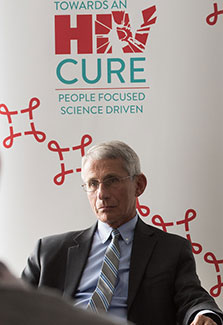NIH-supported HIV research spawns new hope
September / October 2017 | Volume 16, Issue 5

Photo (c) Marcus Rose/IAS
National Institute of Allergy and
Infectious Diseases Director Dr. Anthony
S. Fauci discussed research advances at
the IAS meeting in Paris.
NIH-supported research has played a key role in changing an HIV diagnosis from a certain death sentence in the 1980s to a chronic, manageable disease today. The results from dozens of NIH-funded research projects and clinical studies were presented at the 9th International AIDS Conference on HIV Science in Paris in July, including several groundbreaking findings that could change the way HIV is treated or prevented.
Child with HIV maintains remission
Key among them was the case of a South African child who was diagnosed with HIV at the age of 32 days, started immediately on antiretroviral therapy (ART), and has controlled HIV for nine years since stopping treatment. The National Institute of Allergy and Infectious Diseases (NIAID) at NIH funded the Children with HIV Early Antiretroviral Therapy (CHER) clinical trial, in which the child was enrolled.
The South African child is the third case - the first in Africa - of a child who has sustained viral suppression for at least two years after interrupting ART. While researchers don’t understand how long-term HIV remission was induced in any of the three children, it was an encouraging sign. "This new case strengthens our hope that by treating HIV-infected children for a brief period beginning in infancy, we may be able to spare them the burden of life-long therapy and the health consequences of long-term immune activation typically associated with HIV disease," said NIAID Director Dr. Anthony S. Fauci.
HIV preventive vaccine
NIH researchers continue to explore what Fauci called "multiple promising avenues of vaccine development research." Early results from an NIAID-supported clinical trial of experimental vaccines showed those vaccines were well tolerated and generated immune responses against HIV in healthy adults. The vaccines evaluated in the trial were designed to induce an immune response against the many different HIV subtypes that exist around the world. "A safe and effective HIV vaccine would be a powerful tool to reduce new HIV infections worldwide and help bring about a durable end to the HIV/AIDS pandemic," Fauci said.
Nearly 400 volunteers in Rwanda, South Africa, Thailand, Uganda and the U.S. were enrolled in the trial. They were randomly assigned to receive two prime doses and two booster doses of one of seven experimental vaccines, or a placebo. By the third vaccine, most study participants had developed antibody and cellular immune responses against HIV. The researchers also found that the vaccine that elicited the greatest immune responses in humans was also the most protective in preclinical studies in animals.
Fighting non-adherence
A clinical trial co-funded by NIAID, the National Institute of Child Health and Human Development (NICHD) and the National Institute of Mental Health (NIMH), recently tested the efficacy, safety and adherence among sexually active American teenage girls of a vaginal ring containing anti-HIV drugs. The ring, which only needs to be changed once a month at menses, was found to be safe and acceptable to the girls, whose adherence rates were high. Non-adherence to treatment is a major obstacle standing in the way of ending the HIV epidemic. Issues including drug toxicity, not wanting to take a pill every day, stigma, the cost of long-term treatment, and the risk of the virus becoming resistant to ART are among the causes of non-adherence.
Conference-goers also heard that a daily oral pre-exposure prophylactic (PrEP) pill was safe for and acceptable to teen girls and boys. Most of the 148 participants in that study, conducted in South Africa, took the pill every day, although adherence fell over time. Only one study participant became infected with HIV during the trial - three months after she stopped taking PrEP. Scientists said they are planning a study to test the safety and acceptability of both the vaginal ring and the PrEP pill among girls and young women, aged 16-21, in Africa, a group at high risk for HIV infection.
More Information
To view Adobe PDF files,
download current, free accessible plug-ins from Adobe's website.